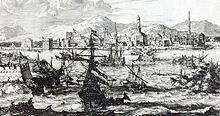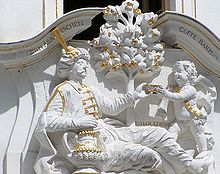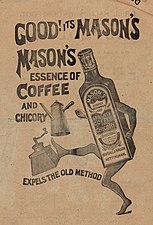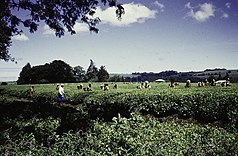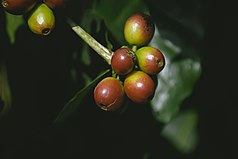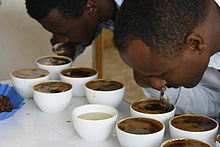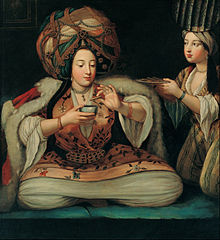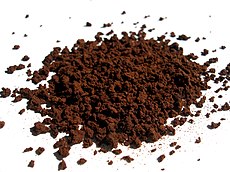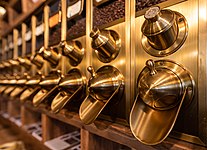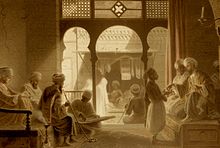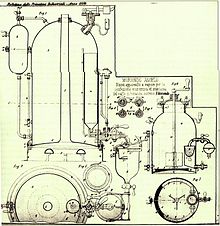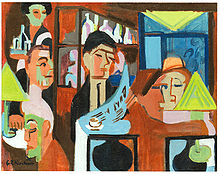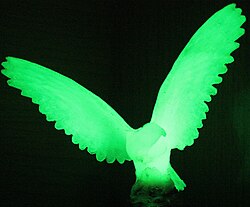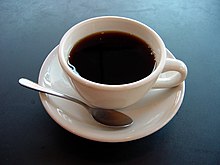 | |
| Type | Hot or ice-cold (usually hot) |
|---|---|
| Region of origin | Horn of Africa and South Arabia |
| Introduced | 15th century |
| Color | Black, dark brown, light brown, beige |
Coffee is a brewed drink prepared from roasted coffee beans, the seeds of berries from certain flowering plants in the Coffea genus. From the coffee fruit, the seeds are separated to produce a stable, raw product: unroasted green coffee. The seeds are then roasted, a process which transforms them into a consumable product: roasted coffee, which is ground into fine particles that are typically steeped in hot water before being filtered out, producing a cup of coffee.
Coffee is darkly colored, bitter, slightly acidic and has a stimulating effect in humans, primarily due to its caffeine content. It is one of the most popular drinks in the world and can be prepared and presented in a variety of ways (e.g., espresso, French press, caffè latte, or already-brewed canned coffee). It is usually served hot, although chilled or iced coffee is common. Sugar, sugar substitutes, milk or cream are often used to lessen the bitter taste or enhance the flavor. It may be served with coffee cake or another sweet dessert, like doughnuts. A commercial establishment that sells prepared coffee beverages is known as a coffeehouse or coffee shop (not to be confused with Dutch coffeeshops selling cannabis).
Clinical research indicates that moderate coffee consumption is benign or mildly beneficial as a stimulant in healthy adults, with continuing research on whether long-term consumption reduces the risk of some diseases, although some of the long-term studies are of questionable credibility.
The earliest credible evidence of the drinking of coffee in the form of the modern beverage appears in modern-day Yemen from the middle of the 15th century in Sufi shrines, where coffee seeds were first roasted and brewed in a manner similar to current methods. The Yemenis procured the coffee beans from the Ethiopian Highlands via coastal Somali intermediaries and began cultivation. By the 16th century, the drink had reached the rest of the Middle East and North Africa, later spreading to Europe.
The two most commonly grown coffee bean types are C. arabica and C. robusta. Coffee plants are cultivated in over 70 countries, primarily in the equatorial regions of the Americas, Southeast Asia, the Indian subcontinent, and Africa. As of 2018, Brazil was the leading grower of coffee beans, producing 35% of the world total. Coffee is a major export commodity as the leading legal agricultural export for numerous countries. It is one of the most valuable commodities exported by developing countries. Green, unroasted coffee is the most traded agricultural commodity and one of the most traded commodities overall, second only to petroleum. Despite the sales of coffee reaching billions of dollars, those actually producing the beans are disproportionately living in poverty. Critics also point to the coffee industry's negative impact on the environment and the clearing of land for coffee-growing and water use. The environmental costs and wage disparity of farmers are causing the market for fair trade and organic coffee to expand.
Etymology
The word coffee entered the English language in 1582 via the Dutch koffie, borrowed from the Ottoman Turkish kahve (قهوه), borrowed in turn from the Arabic qahwah (قَهْوَة). The Arabic word qahwah was traditionally held to refer to a type of wine whose etymology is given by Arab lexicographers as deriving from the verb قَهِيَ qahiya, 'to lack hunger', in reference to the drink's reputation as an appetite suppressant.
The term coffee pot dates from 1705. The expression coffee break was first attested in 1952.
History
Legendary accounts
According to one legend, ancestors of today's Oromo people in a region of Jimma in Ethiopia were the first to recognize the energizing effect of the coffee plant. However, no direct evidence that has been found earlier than the 15th century indicating who among the African populations used it as a stimulant, or where coffee was first cultivated. The story of Kaldi, the 9th-century Ethiopian goatherd who discovered the stimulating effect of coffee when he noticed how excited his goats became after eating the beans from a coffee plant, did not appear in writing until 1671 and is probably apocryphal.
Another legend attributes the discovery of coffee to a Sheikh Omar. According to an old chronicle (preserved in the Abd-Al-Kadir manuscript), Omar, who was known for his ability to cure the sick through prayer, was once exiled from Mocha in Yemen to a desert cave near Ousab (modern-day Wusab, about 90 kilometres (56 mi) east of Zabid, Yemen). Starving, Omar chewed berries from nearby shrubbery but found them to be too bitter. He tried roasting the seeds to improve the flavor, but they became hard. He then tried boiling them to soften the seed, which resulted in a fragrant brown liquid. Upon drinking the liquid, Omar was revitalized and sustained for days. As stories of this "miracle drug" reached Mocha, Omar was asked to return and was made a saint.
Historical transmission
The earliest credible evidence of coffee-drinking or knowledge of the coffee tree appears in the middle of the 15th century in the accounts of Ahmed al-Ghaffar in Yemen. It was here in Arabia that coffee seeds were first roasted and brewed in a similar way to how it is prepared now. Coffee was used by Sufi circles to stay awake for their religious rituals. Accounts differ on the origin of the coffee plant prior to its appearance in Yemen. From Ethiopia, coffee could have been introduced to Yemen via trade across the Red Sea. One account credits Muhammad Ibn Sa'd for bringing the beverage to Aden from the African coast. Other early accounts say Ali ben Omar of the Shadhili Sufi order was the first to introduce coffee to Arabia. According to al Shardi, Ali ben Omar may have encountered coffee during his stay with the Adal king Sadadin's companions in 1401. Famous 16th-century Islamic scholar Ibn Hajar al-Haytami notes in his writings a beverage called qahwa developed from a tree in the Zeila region. Coffee was first exported from Ethiopia to Yemen by Somali merchants from Berbera and Zeila in modern-day Somaliland, which was procured from Harar and the Abyssinian interior. According to Captain Haines, who was the colonial administrator of Aden (1839–1854), Mocha historically imported up to two-thirds of their coffee from Berbera-based merchants before the coffee trade of Mocha was captured by British-controlled Aden in the 19th century. Thereafter, much of the Ethiopian coffee was exported to Aden via Berbera.
Berbera not only supplies Aden with horned cattle and sheep to a very large extent, but the trade between Africa and Aden is steadily increasing greatly every year. In the article of coffee alone there is considerable export, and ' Berbera' coffee stands in the Bombay market now before Mocha. The coffee shipped at Berbera comes from far in the interior from Hurrar, Abyssinia, and Kaffa. It will be to the advantage of all that the trade should come to Aden through one port, and Berbera is the only place on the coast there that has a protected port, where vessels can lie in smooth water.
By the 16th century, coffee had reached the rest of the Middle East, Persia, Turkey, and northern Africa. The first coffee seeds were smuggled out of the Middle East by Sufi Baba Budan from Yemen to the Indian subcontinent during the time. Before then, all exported coffee was boiled or otherwise sterilised. Portraits of Baba Budan depict him as having smuggled seven coffee seeds by strapping them to his chest. The first plants grown from these smuggled seeds were planted in Mysore.
Coffee had spread to Italy by 1600, and then to the rest of Europe, Indonesia, and the Americas.
In 1583, Leonhard Rauwolf, a German physician, gave this description of coffee after returning from a ten-year trip to the Near East:
A beverage as black as ink, useful against numerous illnesses, particularly those of the stomach. Its consumers take it in the morning, quite frankly, in a porcelain cup that is passed around and from which each one drinks a cupful. It is composed of water and the fruit from a bush called bunnu.
— Léonard Rauwolf, Reise in die Morgenländer (in German)
The thriving trade between Venice and North Africa, Egypt, and the Middle East (back then Ottoman Empire) brought many goods, including coffee, to the Venetian port. From Venice, it was introduced to the rest of Europe. Coffee became more widely accepted after it was deemed a Christian beverage by Pope Clement VIII in 1600, despite appeals to ban the "Muslim drink". The first European coffee house opened in Rome in 1645.
The Dutch East India Company was the first to import coffee on a large scale. The Dutch later grew the crop in Java and Ceylon. The first exports of Indonesian coffee from Java to the Netherlands occurred in 1711.
Through the efforts of the British East India Company, coffee became popular in England as well. In a diary entry of May 1637, John Evelyn recorded tasting the drink at Oxford in England, where it had been brought by a student of Balliol College from Crete named Nathaniel Conopios of Crete. Oxford's Queen's Lane Coffee House, established in 1654, is still in existence today. Coffee was introduced in France in 1657, and in Austria and Poland after the 1683 Battle of Vienna, when coffee was captured from supplies of the defeated Turks.
When coffee reached North America during the Colonial period, it was initially not as successful as it had been in Europe, as alcoholic beverages remained more popular. During the Revolutionary War, the demand for coffee increased so much that dealers had to hoard their scarce supplies and raise prices dramatically; this was also due to the reduced availability of tea from British merchants, and a general resolution among many Americans to avoid drinking tea following the 1773 Boston Tea Party. After the War of 1812, during which Britain temporarily cut off access to tea imports, the Americans' taste for coffee grew.
During the 18th century, coffee consumption declined in England, giving way to tea-drinking. The latter beverage was simpler to make and had become cheaper with the British conquest of India and the tea industry there. During the Age of Sail, seamen aboard ships of the British Royal Navy made substitute coffee by dissolving burnt bread in hot water.
The Frenchman Gabriel de Clieu took a coffee plant to the French territory of Martinique in the Caribbean in the 1720s, from which much of the world's cultivated arabica coffee is descended. Coffee thrived in the climate and was conveyed across the Americas. Coffee was cultivated in Saint-Domingue (now Haiti) from 1734, and by 1788 it supplied half the world's coffee. The conditions that the slaves worked in on coffee plantations were a factor in the soon to follow Haitian Revolution. The coffee industry never fully recovered there. It made a brief come-back in 1949 when Haiti was the world's 3rd largest coffee exporter, but declined rapidly after that.
Meanwhile, coffee had been introduced to Brazil in 1727, although its cultivation did not gather momentum until independence in 1822. After this time, massive tracts of rainforest were cleared for coffee plantations, first in the vicinity of Rio de Janeiro and later São Paulo. Brazil went from having essentially no coffee exports in 1800 to being a significant regional producer in 1830, to being the largest producer in the world by 1852. In 1910–20, Brazil exported around 70% of the world's coffee, Colombia, Guatemala, and Venezuela exported half of the remaining 30%, and Old World production accounted for less than 5% of world exports.
Cultivation was taken up by many countries in Central America in the latter half of the 19th century, and almost all involved the large-scale displacement and exploitation of the indigenous people. Harsh conditions led to many uprisings, coups and bloody suppression of peasants. The notable exception was Costa Rica, where lack of ready labor prevented the formation of large farms. Smaller farms and more egalitarian conditions ameliorated unrest over the 19th and 20th centuries.
Rapid growth in coffee production in South America during the second half of the 19th century was matched by growth in consumption in developed countries, though nowhere has this growth been as pronounced as in the United States, where a high rate of population growth was compounded by doubling of per capita consumption between 1860 and 1920. Though the United States was not the heaviest coffee-drinking nation at the time (Nordic countries, Belgium, and Netherlands all had comparable or higher levels of per capita consumption), due to its sheer size, it was already the largest consumer of coffee in the world by 1860, and, by 1920, around half of all coffee produced worldwide was consumed in the US.
Coffee has become a vital cash crop for many developing countries. Over one hundred million people in developing countries have become dependent on coffee as their primary source of income. It has become the primary export and backbone for African countries like Uganda, Burundi, Rwanda, and Ethiopia, as well as many Central American countries.
Biology
Several species of shrub of the genus Coffea produce the berries from which coffee is extracted. The two main species commercially cultivated are Coffea canephora (predominantly a form known as 'robusta') and C. arabica. C. arabica, the most highly regarded species, is native to the southwestern highlands of Ethiopia and the Boma Plateau in southeastern Sudan and Mount Marsabit in northern Kenya. C. canephora is native to western and central Subsaharan Africa, from Guinea to Uganda and southern Sudan. Less popular species are C. liberica, C. stenophylla, C. mauritiana, and C. racemosa.
All coffee plants are classified in the large family Rubiaceae. They are evergreen shrubs or trees that may grow 5 m (15 ft) tall when unpruned. The leaves are dark green and glossy, usually 10–15 cm (4–6 in) long and 6 cm (2.4 in) wide, simple, entire, and opposite. Petioles of opposite leaves fuse at the base to form interpetiolar stipules, characteristic of Rubiaceae. The flowers are axillary, and clusters of fragrant white flowers bloom simultaneously. Gynoecium consists of an inferior ovary, also characteristic of Rubiaceae. The flowers are followed by oval berries of about 1.5 cm (0.6 in). When immature, they are green, and they ripen to yellow, then crimson, before turning black on drying. Each berry usually contains two seeds, but 5–10% of the berries have only one; these are called peaberries. Arabica berries ripen in six to eight months, while robusta takes nine to eleven months.
Coffea arabica is predominantly self-pollinating, and as a result, the seedlings are generally uniform and vary little from their parents. In contrast, Coffea canephora, and C. liberica are self-incompatible and require outcrossing. This means that useful forms and hybrids must be propagated vegetatively. Cuttings, grafting, and budding are the usual methods of vegetative propagation. On the other hand, there is great scope for experimentation in search of potential new strains.
In 2016, Oregon State University entomologist George Poinar, Jr. announced the discovery of a new plant species which is a 45-million-year-old relative of coffee found in amber. Named Strychnos electri, after the Greek word for amber (electron), the flowers represent the first-ever fossils of an asterid, which is a clade of flowering plants that not only later gave us coffee, but also sunflowers, peppers, potatoes, mint – and deadly poisons.
Cultivation
r: Coffea canephora
m: Coffea canephora and Coffea arabica
a: Coffea arabica
The traditional method of planting coffee is to place 20 seeds in each hole at the beginning of the rainy season. This method loses about 50% of the seeds' potential, as about half fail to sprout. A more effective process of growing coffee, used in Brazil, is to raise seedlings in nurseries that are then planted outside at six to twelve months. Coffee is often intercropped with food crops, such as corn, beans, or rice during the first few years of cultivation as farmers become familiar with its requirements. Coffee plants grow within a defined area between the tropics of Cancer and Capricorn, termed the bean belt or coffee belt.
Of the two main species grown, arabica coffee (from C. arabica) is generally more highly regarded than robusta coffee (from C. canephora). Robusta coffee tends to be bitter and have less flavor but better body than arabica. For these reasons, about three-quarters of coffee cultivated worldwide is C. arabica. Robusta strains also contain about 40–50% more caffeine than arabica. Consequently, this species is used as an inexpensive substitute for arabica in many commercial coffee blends. Good quality robusta beans are used in traditional Italian espresso blends to provide a full-bodied taste and a better foam head (known as crema).
Additionally, Coffea canephora is less susceptible to disease than C. arabica and can be cultivated in lower altitudes and warmer climates where C. arabica will not thrive. The robusta strain was first collected in 1890 from the Lomani River, a tributary of the Congo River, and was conveyed from the Congo Free State (now the Democratic Republic of the Congo) to Brussels to Java around 1900. From Java, further breeding resulted in the establishment of robusta plantations in many countries. In particular, the spread of the devastating coffee leaf rust (Hemileia vastatrix), to which C. arabica is vulnerable, hastened the uptake of the resistant robusta. Hemileia vastatrix is a fungal pathogen and results in light, rust-colored spots on the undersides of coffee plant leaves. Hemileia vastatrix grows exclusively on the leaves of coffee pants. Coffee leaf rust is found in virtually all countries that produce coffee.
Mycena citricolor is another threat to coffee plants, primarily in Latin America. Mycena citricolor, commonly referred to as American Leaf Spot, is a fungus that can affect the whole coffee plant. It can grow on leaves, resulting in leaves with holes that often fall from the plant.
Over 900 species of insect have been recorded as pests of coffee crops worldwide. Of these, over a third are beetles, and over a quarter are bugs. Some 20 species of nematodes, 9 species of mites, and several snails and slugs also attack the crop. Birds and rodents sometimes eat coffee berries, but their impact is minor compared to invertebrates. In general, arabica is the more sensitive species to invertebrate predation overall. Each part of the coffee plant is assailed by different animals. Nematodes attack the roots, coffee borer beetles burrow into stems and woody material, and the foliage is attacked by over 100 species of larvae (caterpillars) of butterflies and moths.
Mass spraying of insecticides has often proven disastrous, as predators of the pests are more sensitive than the pests themselves. Instead, integrated pest management has developed, using techniques such as targeted treatment of pest outbreaks, and managing crop environment away from conditions favouring pests. Branches infested with scale are often cut and left on the ground, which promotes scale parasites to not only attack the scale on the fallen branches but in the plant as well.
The 2-mm-long coffee borer beetle (Hypothenemus hampei) is the most damaging insect pest to the world's coffee industry, destroying up to 50 percent or more of the coffee berries on plantations in most coffee-producing countries. The adult female beetle nibbles a single tiny hole in a coffee berry and lays 35 to 50 eggs. Inside, the offspring grow, mate, and then emerge from the commercially ruined berry to disperse, repeating the cycle. Pesticides are mostly ineffective because the beetle juveniles are protected inside the berry nurseries, but they are vulnerable to predation by birds when they emerge. When groves of trees are nearby, the American yellow warbler, rufous-capped warbler, and other insectivorous birds have been shown to reduce by 50 percent the number of coffee berry borers in Costa Rica coffee plantations.
Beans from different countries or regions can usually be distinguished by differences in flavor, aroma, body, and acidity. These taste characteristics are dependent not only on the coffee's growing region, but also on genetic subspecies (varietals) and processing. Varietals are generally known by the region in which they are grown, such as Colombian, Java and Kona.
Arabica coffee beans are cultivated mainly in Latin America, eastern Africa or Asia, while robusta beans are grown in central Africa, throughout southeast Asia, and Brazil.
Ecological effects
Originally, coffee farming was done in the shade of trees that provided a habitat for many animals and insects. Remnant forest trees were used for this purpose, but many species have been planted as well. These include leguminous trees of the genera Acacia, Albizia, Cassia, Erythrina, Gliricidia, Inga, and Leucaena, as well as the nitrogen-fixing non-legume sheoaks of the genus Casuarina, and the silky oak Grevillea robusta.
This method is commonly referred to as the traditional shaded method, or "shade-grown". Starting in the 1970s, many farmers switched their production method to sun cultivation, in which coffee is grown in rows under full sun with little or no forest canopy. This causes berries to ripen more rapidly and bushes to produce higher yields, but requires the clearing of trees and increased use of fertilizer and pesticides, which damage the environment and cause health problems.
Unshaded coffee plants grown with fertilizer yield the most coffee, although unfertilized shaded crops generally yield more than unfertilized unshaded crops: the response to fertilizer is much greater in full sun. While traditional coffee production causes berries to ripen more slowly and produce lower yields, the quality of the coffee is allegedly superior. In addition, the traditional shaded method provides living space for many wildlife species. Proponents of shade cultivation say environmental problems such as deforestation, pesticide pollution, habitat destruction, and soil and water degradation are the side effects of the practices employed in sun cultivation.
The American Birding Association, Smithsonian Migratory Bird Center, National Arbor Day Foundation, and the Rainforest Alliance have led a campaign for 'shade-grown' and organic coffees, which can be sustainably harvested. Shaded coffee cultivation systems show greater biodiversity than full-sun systems, and those more distant from continuous forest compare rather poorly to undisturbed native forest in terms of habitat value for some bird species.
Coffee production use a large volume of water. On average it takes about 140 liters (37 U.S. gal) of water to grow the coffee beans needed to produce one cup of coffee, producing 1 kg (2.2 lb) of roasted coffee in Africa, South America or Asia requires 26,400 liters (7,000 U.S. gal) of water. Coffee is often grown in countries where there is a water shortage, such as Ethiopia.
Used coffee grounds may be used for composting or as a mulch. They are especially appreciated by worms and acid-loving plants such as blueberries. Some commercial coffee shops run initiatives to make better use of these grounds, including Starbucks' "Grounds for your Garden" project, and community sponsored initiatives such as "Ground to Ground".
Climate change may significantly impact coffee yields during the 21st century, such as in Nicaragua and Ethiopia which could lose more than half of the farming land suitable for growing (Arabica) coffee.
As of 2016, at least 34% of global coffee production was compliant with voluntary sustainability standards such as Fairtrade, UTZ, and 4C (The Common Code for the Coffee Community).
Sustainable production
Production
| Green coffee production – 2020 | |
|---|---|
| Country | Production (in thousand 60-kg bags) |
| 69,000 | |
| 29,000 | |
| 12,400 | |
| 14,300 | |
| 7,373 | |
| 6,100 | |
| 5,700 | |
| World | 175,647 |
| Source: ICO | |
In 2020, world production of green coffee beans was 175,647,000 60 kg bags, led by Brazil with 39% of the total (table). Vietnam, Indonesia, and Colombia were other major producers.
As of 2021, no synthetic coffee products were publicly available but multiple bioeconomy companies have reportedly produced first batches that are highly similar on the molecular level and are close to commercialization.
Processing
Coffee berries and their seeds undergo several processes before they become the familiar roasted coffee. Berries have been traditionally selectively picked by hand; a labor-intensive method, it involves the selection of only the berries at the peak of ripeness. More commonly, crops are strip picked, where all berries are harvested simultaneously regardless of ripeness by person or machine. After picking, green coffee is processed by one of two types of method—a dry process type of method which is often simpler and less labor-intensive, and a wet process type of method, which incorporates batch fermentation, uses larger amounts of water in the process, and often yields a milder coffee.
Then they are sorted by ripeness and color, and most often the flesh of the berry is removed, usually by machine, and the seeds are fermented to remove the slimy layer of mucilage still present on the seed. When the fermentation is finished, the seeds are washed with large quantities of fresh water to remove the fermentation residue, which generates massive amounts of coffee wastewater. Finally, the seeds are dried.
The best (but least used) method of drying coffee is using drying tables. In this method, the pulped and fermented coffee is spread thinly on raised beds, which allows the air to pass on all sides of the coffee, and then the coffee is mixed by hand. In this method the drying that takes place is more uniform, and fermentation is less likely. Most African coffee is dried in this manner and certain coffee farms around the world are starting to use this traditional method.
Next, the coffee is sorted, and labeled as green coffee. Some companies use cylinders to pump in heated air to dry the coffee seeds, though this is generally in places where the humidity is very high.
An Asian coffee known as kopi luwak undergoes a peculiar process made from coffee berries eaten by the Asian palm civet, passing through its digestive tract, with the beans eventually harvested from feces. Coffee brewed from this process is among the most expensive in the world, with bean prices reaching $160 per pound or $30 per brewed cup. Kopi luwak coffee is said to have uniquely rich, slightly smoky aroma and flavor with hints of chocolate, resulting from the action of digestive enzymes breaking down bean proteins to facilitate partial fermentation.
In Thailand, black ivory coffee beans are fed to elephants whose digestive enzymes reduce the bitter taste of beans collected from dung. These beans sell for up to $1,100 a kilogram ($500 per lb), achieving the world's most expensive coffee, three times costlier than palm civet coffee beans.
Roasting
The next step in the process is the roasting of the green coffee. Coffee is usually sold in a roasted state, and with rare exceptions, such as infusions from green coffee beans, coffee is roasted before it is consumed. It can be sold roasted by the supplier, or it can be home roasted. The roasting process influences the taste of the beverage by changing the coffee bean both physically and chemically. The bean decreases in weight as moisture is lost and increases in volume, causing it to become less dense. The density of the bean also influences the strength of the coffee and requirements for packaging.
The actual roasting begins when the temperature inside the bean reaches approximately 200 °C (392 °F), though different varieties of seeds differ in moisture and density and therefore roast at different rates. During roasting, caramelization occurs as intense heat breaks down starches, changing them to simple sugars that begin to brown, which alters the color of the bean.
Sucrose is rapidly lost during the roasting process, and may disappear entirely in darker roasts. During roasting, aromatic oils and acids weaken, changing the flavor; at 205 °C (401 °F), other oils start to develop. One of these oils, caffeol, is created at about 200 °C (392 °F), which is largely responsible for coffee's aroma and flavor.
Roasting is the last step of processing the beans in their intact state. During this last treatment, while still in the bean state, more caffeine breaks down above 235 °C (455 °F). Dark roasting is the utmost step in bean processing removing the most caffeine. Although, dark roasting is not to be confused with the decaffeination process.
Grading roasted beans
Depending on the color of the roasted beans as perceived by the human eye, they will be labeled as light, medium light, medium, medium dark, dark, or very dark. A more accurate method of discerning the degree of roast involves measuring the reflected light from roasted seeds illuminated with a light source in the near-infrared spectrum. This elaborate light meter uses a process known as spectroscopy to return a number that consistently indicates the roasted coffee's relative degree of roast or flavor development.
Roast characteristics
The degree of roast has an effect upon coffee flavor and body. Darker roasts are generally bolder because they have less fiber content and a more sugary flavor. Lighter roasts have a more complex and therefore perceived stronger flavor from aromatic oils and acids otherwise destroyed by longer roasting times. Roasting does not alter the amount of caffeine in the bean, but does give less caffeine when the beans are measured by volume because the beans expand during roasting.
A small amount of chaff is produced during roasting from the skin left on the seed after processing. Chaff is usually removed from the seeds by air movement, though a small amount is added to dark roast coffees to soak up oils on the seeds.
Decaffeination
Decaffeination of coffee seeds is done while the seeds are still green. Many methods can remove caffeine from coffee, but all involve either soaking the green seeds in hot water (often called the "Swiss water process") or steaming them, then using a solvent to dissolve caffeine-containing oils. Decaffeination is often done by processing companies, and the extracted caffeine is usually sold to the pharmaceutical industry.
Storage
Coffee is best stored in an airtight container made of ceramic, glass or non-reactive metal. Higher quality prepackaged coffee usually has a one-way valve which prevents air from entering while allowing the coffee to release gases. Coffee freshness and flavor is preserved when it is stored away from moisture, heat, and light. The tendency of coffee to absorb strong smells from food means that it should be kept away from such smells. Storage of coffee in refrigerators is not recommended due to the presence of moisture which can cause deterioration. Exterior walls of buildings which face the sun may heat the interior of a home, and this heat may damage coffee stored near such a wall. Heat from nearby ovens also harms stored coffee.
In 1931, a method of packing coffee in a sealed vacuum in cans was introduced. The roasted coffee was packed and then 99% of the air was removed, allowing the coffee to be stored indefinitely until the can was opened. Today this method is in mass use for coffee in a large part of the world.
Brewing
Coffee beans must be ground and brewed to create a beverage. The criteria for choosing a method include flavor and economy. Almost all methods of preparing coffee require that the beans be ground and then mixed with hot water long enough to allow the flavor to emerge but not so long as to draw out bitter compounds. The liquid can be consumed after the spent grounds are removed. Brewing considerations include the fineness of grind, the way in which the water is used to extract the flavor, the ratio of coffee grounds to water (the brew ratio), additional flavorings such as sugar, milk, and spices, and the technique to be used to separate spent grounds. Optimal coffee extraction occurs between 91 and 96 °C (196 and 205 °F). Ideal holding temperatures range from 85 to 88 °C (185 to 190 °F) to as high as 93 °C (199 °F) and the ideal serving temperature is 68 to 79 °C (154 to 174 °F). The recommended brew ratio for non-espresso coffee is around 55 to 60 grams of grounds per litre of water, or two level tablespoons for a 150-to-180-millilitre (5 to 6 US fl oz) cup.
The roasted coffee beans may be ground at a roastery, in a grocery store, or in the home. Most coffee is roasted and ground at a roastery and sold in packaged form, though roasted coffee beans can be ground at home immediately before consumption. It is also possible, though uncommon, to roast raw beans at home.
Coffee beans may be ground in various ways. A burr grinder uses revolving elements to shear the seed; a blade grinder cuts the seeds with blades moving at high speed; and a mortar and pestle crushes the seeds. For most brewing methods a burr grinder is deemed superior because the grind is more even and the grind size can be adjusted.
The type of grind is often named after the brewing method for which it is generally used. Turkish grind is the finest grind, while coffee percolator or French press are the coarsest grinds. The most common grinds are between these two extremes: a medium grind is used in most home coffee-brewing machines.
Coffee may be brewed by several methods. It may be boiled, steeped, or pressurized.
Brewing coffee by boiling was the earliest method, and Turkish coffee is an example of this method. It is prepared by grinding or pounding the seeds to a fine powder, then adding it to water and bringing it to the boil for no more than an instant in a pot called a cezve or, in Greek, a μπρίκι : bríki (from Turkish ibrik). This produces a strong coffee with a layer of foam on the surface and sediment (which is not meant for drinking) settling at the bottom of the cup.
Coffee percolators and automatic coffeemakers brew coffee using gravity. In an automatic coffeemaker, hot water drips onto coffee grounds that are held in a paper, plastic, or perforated metal coffee filter, allowing the water to seep through the ground coffee while extracting its oils and essences. The liquid drips through the coffee and the filter into a carafe or pot, and the spent grounds are retained in the filter.
In a percolator, boiling water is forced into a chamber above a filter by steam pressure created by boiling. The water then seeps through the grounds, and the process is repeated until terminated by removing from the heat, by an internal timer, or by a thermostat that turns off the heater when the entire pot reaches a certain temperature.
Coffee may be brewed by steeping in a device such as a French press (also known as a cafetière, coffee press or coffee plunger). Ground coffee and hot water are combined in a cylindrical vessel and left to brew for a few minutes. A circular filter which fits tightly in the cylinder fixed to a plunger is then pushed down from the top to force the grounds to the bottom. The filter retains the grounds at the bottom as the coffee is poured from the container. Because the coffee grounds are in direct contact with the water, all the coffee oils remain in the liquid, making it a stronger beverage. This method of brewing leaves more sediment than in coffee made by an automatic coffee machine. Supporters of the French press method point out that the sediment issue can be minimized by using the right type of grinder: they claim that a rotary blade grinder cuts the coffee bean into a wide range of sizes, including a fine coffee dust that remains as sludge at the bottom of the cup, while a burr grinder uniformly grinds the beans into consistently-sized grinds, allowing the coffee to settle uniformly and be trapped by the press. Within the first minute of brewing 95% of the caffeine is released from the coffee bean.
The espresso method forces hot pressurized and vaporized water through ground coffee. As a result of brewing under high pressure (typically 9 bar), the espresso beverage is more concentrated (as much as 10 to 15 times the quantity of coffee to water as gravity-brewing methods can produce) and has a more complex physical and chemical constitution. A well-prepared espresso has a reddish-brown foam called crema that floats on the surface. Other pressurized water methods include the moka pot and vacuum coffee maker.
Cold brew coffee is made by steeping coarsely ground beans in cold water for several hours, then filtering them. This results in a brew lower in acidity than most hot-brewing methods.
Nutrition
Brewed coffee from typical grounds prepared with tap water contains 40 mg caffeine per 100 gram and no essential nutrients in significant content. In espresso, however, likely due to its higher amount of suspended solids, there are significant contents of magnesium, the B vitamins, niacin and riboflavin, and 212 mg of caffeine per 100 grams of grounds.
Serving
Once brewed, coffee may be served in a variety of ways. Drip-brewed, percolated, or French-pressed/cafetière coffee may be served as white coffee with a dairy product such as milk or cream, or dairy substitute, or as black coffee with no such addition. It may be sweetened with sugar or artificial sweetener. When served cold, it is called iced coffee.
Espresso-based coffee has a variety of possible presentations. In its most basic form, an espresso is served alone as a shot or short black, or with hot water added, when it is known as Caffè Americano. A long black is made by pouring a double espresso into an equal portion of water, retaining the crema, unlike Caffè Americano. Milk is added in various forms to an espresso: steamed milk makes a caffè latte, equal parts steamed milk and milk froth make a cappuccino, and a dollop of hot foamed milk on top creates a caffè macchiato. A flat white is prepared by adding steamed hot milk (microfoam) to espresso so that the flavour is brought out and the texture is unusually velvety. It has less milk than a latte, but both are varieties of coffee to which the milk can be added in such a way as to create a decorative surface pattern. Such effects are known as latte art.
Coffee can also be incorporated with alcohol to produce a variety of beverages: it is combined with whiskey in Irish coffee, and it forms the base of alcoholic coffee liqueurs such as Kahlúa and Tia Maria. Darker beers such as stout and porter give a chocolate or coffee-like taste due to roasted grains even though actual coffee beans are not added to it.
Instant coffee
A number of products are sold for the convenience of consumers who do not want to prepare their own coffee or who do not have access to coffeemaking equipment. Instant coffee is dried into soluble powder or freeze-dried into granules that can be quickly dissolved in hot water. Originally invented in 1907, it rapidly gained in popularity in many countries in the post-war period, with Nescafé being the most popular product. Many consumers determined that the convenience in preparing a cup of instant coffee more than made up for a perceived inferior taste, although, since the late 1970s, instant coffee has been produced differently in such a way that is similar to the taste of freshly brewed coffee. Paralleling (and complementing) the rapid rise of instant coffee was the coffee vending machine invented in 1947 and widely distributed since the 1950s.
Canned coffee has been popular in Asian countries for many years, particularly in China, Japan, South Korea, and Taiwan. Vending machines typically sell varieties of flavored canned coffee, much like brewed or percolated coffee, available both hot and cold. Japanese convenience stores and groceries also have a wide availability of bottled coffee drinks, which are typically lightly sweetened and pre-blended with milk. Bottled coffee drinks are also consumed in the United States.
Liquid coffee concentrates are sometimes used in large institutional situations where coffee needs to be produced for thousands of people at the same time. It is described as having a flavor about as good as low-grade robusta coffee, and costs about 10¢ a cup to produce. The machines can process up to 500 cups an hour, or 1,000 if the water is preheated.
Sale and distribution
Brazil is the largest coffee exporting nation, accounting for 15% of all world exports in 2019.
Commodity market
Coffee is bought and sold as green coffee beans by roasters, investors, and price speculators as a tradable commodity in commodity markets and exchange-traded funds. Coffee futures contracts for Grade 3 washed arabicas are traded on the New York Mercantile Exchange under ticker symbol KC, with contract deliveries occurring every year in March, May, July, September, and December. Coffee is an example of a product that has been susceptible to significant commodity futures price variations. Higher and lower grade arabica coffees are sold through other channels. Futures contracts for robusta coffee are traded on the London International Financial Futures and Options Exchange and, since 2007, on the New York Intercontinental Exchange.
Dating to the 1970s, coffee has been incorrectly described by many, including historian Mark Pendergrast, as the world's "second most legally traded commodity". Instead, "coffee was the second most valuable commodity exported by developing countries," from 1970 to circa 2000. This fact was derived from the United Nations Conference on Trade and Development Commodity Yearbooks which show "Third World" commodity exports by value in the period 1970–1998 as being in order of crude oil in first place, coffee in second, followed by sugar, cotton, and others. Coffee continues to be an important commodity export for developing countries, but more recent figures are not readily available due to the shifting and politicized nature of the category "developing country".
International Coffee Day, which is claimed to have originated in Japan in 1983 with an event organized by the All Japan Coffee Association, takes place on 29 September in several countries.
Industry advocacy
There are numerous trade associations and lobbying and other organizations funded by the coffee industry, including the International Coffee Organization, Specialty Coffee Association of Indonesia, the National Coffee Association and the British Coffee Association.
Consumption
Nordic countries are the highest coffee consuming nations; consumption in Finland is the world's highest, close to or more than double that of Brazil; Italy; France; Greece; and Canada, which is the 10th-highest consumer, and close to triple coffee consumption in the United States, which ranked 25th in 2018. The top 10 coffee consuming countries, measured per capita, per annum are:
- Finland – 12 kg (26 lb)
- Norway – 9.9 kg (21 lb 13 oz)
- Iceland – 9 kg (20 lb)
- Denmark – 8.7 kg (19 lb 3 oz)
- Netherlands – 8.4 kg (18 lb 8 oz)
- Sweden – 8.2 kg (18 lb 1 oz)
- Switzerland – 7.9 kg (17 lb 7 oz)
- Belgium – 6.8 kg (15 lb 0 oz)
- Luxembourg – 6.5 kg (14 lb 5 oz)
- Canada – 6.5 kg (14 lb 5 oz)
Health effects
A 2017 review of clinical trials found that drinking coffee is generally safe within usual levels of intake and is more likely to improve health outcomes than to cause harm at doses of 3 or 4 cups of coffee daily. Exceptions include possible increased risk in women having bone fractures, and a possible increased risk in pregnant women of fetal loss or decreased birth weight. Results were complicated by poor study quality, and differences in age, gender, health status, and serving size.
Digestion
A 1999 review found that coffee does not cause indigestion, but may promote gastrointestinal reflux. Two reviews of clinical studies on people recovering from abdominal, colorectal, and gynecological surgery found that coffee consumption was safe and effective for enhancing postoperative gastrointestinal function.
Mortality
In 2012, the National Institutes of Health–AARP Diet and Health Study found that higher coffee consumption was associated with lower risk of death, and that those who drank any coffee lived longer than those who did not. However the authors noted, "whether this was a causal or associational finding cannot be determined from our data." A 2014 meta-analysis found that coffee consumption (4 cups/day) was inversely associated with all-cause mortality (a 16% lower risk), as well as cardiovascular disease mortality specifically (a 21% lower risk from drinking 3 cups/day), but not with cancer mortality with exception being oral cancer mortality.
Additional meta-analyses corroborated these findings, showing that higher coffee consumption (2–4 cups per day) was associated with a reduced risk of death by all disease causes. An association of coffee drinking with reduced risk for death from various sources was confirmed by a widely cited prospective cohort study of ten European countries in 2017.
Cardiovascular disease
Moderate coffee consumption is not a risk factor for coronary heart disease. A 2012 meta-analysis concluded that people who drank moderate amounts of coffee had a lower rate of heart failure, with the biggest effect found for those who drank more than four cups a day. A 2014 meta-analysis concluded that cardiovascular disease, such as coronary artery disease and stroke, is less likely with three to five cups of non-decaffeinated coffee per day, but more likely with over five cups per day. A 2016 meta-analysis showed that coffee consumption was associated with a reduced risk of death in patients who have had a myocardial infarction.
The effect of no or moderate daily consumption of coffee on risk for developing hypertension has been assessed in several reviews during the 21st century. A 2019 review found that one to two cups consumed per day had no effect on hypertension risk, whereas drinking three or more cups per day reduced the risk, a finding in agreement with a 2017 analysis which showed a 9% lower risk of hypertension with long-term consumption of up to seven cups of coffee per day. Another review in 2018 found that the risk of hypertension was reduced by 2% with each one cup per day increment of coffee consumption up to 8 cups per day, compared with people who did not consume any coffee. By contrast, a 2011 review had found that drinking one to three cups of coffee per day may pose a slightly increased risk of developing hypertension.
Mental health
The UK National Health Service advises that avoiding coffee may reduce anxiety. Caffeine, the major active ingredient in coffee, is associated with anxiety. At high doses, typically greater than 300 mg, caffeine can both cause and worsen anxiety. For some people, discontinuing caffeine use can significantly reduce anxiety. Caffeine-induced anxiety disorder is a subclass of substance- or medication-induced anxiety disorder. Populations that may be most impacted by caffeine consumption are adolescents and those already suffering anxiety disorders. Preliminary research indicated the possibility of a beneficial relationship between coffee intake and reduced depression. Long-term preliminary research, including assessment of symptoms for dementia and cognitive impairment, was inconclusive for coffee having an effect in the elderly, mainly due to the poor quality of the studies.
Parkinson's disease
Meta-analyses have consistently found that long-term coffee consumption is associated with a lower risk of Parkinson's disease.
Type II diabetes
In a systematic review and meta-analysis of 28 prospective observational studies, representing over one million participants, every additional cup of caffeinated and decaffeinated coffee consumed in a day was associated, respectively, with a 9% and 6% lower risk of type 2 diabetes.
Cancer
Research on the effects of coffee consumption on cancer risk generally has indicated no effect or a slightly lower risk of cancer, particularly in the liver.
Liver disease
Increasing evidence has shown that coffee consumption is protective against the progression of liver disease to cirrhosis. This is associated with antioxidant and anti-fibrotic effects of coffee.
Pharmacology
One psychoactive chemical in coffee is caffeine, an adenosine receptor antagonist that is known for its stimulant effects. Coffee also contains the monoamine oxidase inhibitors β-carboline and harmane, which may contribute to its psychoactivity.
In a healthy liver, caffeine is mostly broken down by hepatic enzymes. The excreted metabolites are mostly paraxanthines—theobromine and theophylline—and a small amount of unchanged caffeine. Therefore, the metabolism of caffeine depends on the state of this enzymatic system of the liver.
Polyphenols in coffee have been shown to affect free radicals in vitro, but there is no evidence that this effect occurs in humans. Polyphenol levels vary depending on how beans are roasted as well as for how long. As interpreted by the Linus Pauling Institute and the European Food Safety Authority, dietary polyphenols, such as those ingested by consuming coffee, have little or no direct antioxidant value following ingestion.
Caffeine content
Depending on the type of coffee and method of preparation, the caffeine content of a single serving can vary greatly. The caffeine content of a cup of coffee varies depending mainly on the brewing method, and also on the coffee variety. According to the USDA National Nutrient Database, a 240-millilitre (8 US fl oz) cup of "coffee brewed from grounds" contains 95 mg caffeine, whereas an espresso (25 ml) contains 53 mg.
According to an article in the Journal of the American Dietetic Association, coffee has the following caffeine content, depending on how it is prepared:
| Serving size | Caffeine content | |
|---|---|---|
| Brewed | 200 mL (7 US fl oz) | 80–135 mg |
| Drip | 200 mL (7 US fl oz) | 115–175 mg |
| Espresso | 45–60 mL (1+1⁄2–2 US fl oz) | 100 mg |
Caffeine remains stable up to 200 °C (392 °F) and completely decomposes around 285 °C (545 °F). Given that roasting temperatures don't exceed 200 °C (392 °F) for long and rarely if ever reach 285 °C (545 °F), the caffeine content of a coffee is not likely changed much by the roasting process.
Coffeehouses
Widely known as coffeehouses or cafés, establishments serving prepared coffee or other hot beverages have existed for over five hundred years. The first coffeehouse in Constantinople was opened in 1475 by traders arriving from Damascus and Aleppo. Soon after, coffeehouses became part of the Ottoman culture, spreading rapidly to all regions of the Ottoman Empire.
Coffeehouses in Mecca became a concern as places for political gatherings to the imams who banned them, and the drink, for Muslims between 1512 and 1524. In 1530 the first coffeehouse was opened in Damascus.
In the 17th century, coffee appeared for the first time in Europe outside the Ottoman Empire, and coffeehouses were established and quickly became popular. The first coffeehouses in Western Europe appeared in Venice, as a result of the traffic between La Serenissima and the Ottomans; the very first one is recorded in 1645. The first coffeehouse in England was set up in Oxford in 1650 by a Jewish man named Jacob in the building now known as "The Grand Cafe". A plaque on the wall still commemorates this; the café is now a cocktail bar. By 1675, there were more than 3,000 coffeehouses in England.
A legend says that after the second Turkish siege of Vienna in 1683, the Viennese discovered many bags of coffee in the abandoned Ottoman encampment. Using this captured stock, a Polish soldier named Kulczycki opened the first coffeehouse in Vienna. This story never happened. Nowadays it is proven that the first coffeehouse in Vienna was opened by the Armenian Johannes Theodat in 1685.
In 1672 an Armenian named Pascal established a coffee stall in Paris that was ultimately unsuccessful and the city had to wait until 1689 for its first coffeehouse when Procopio Cutò opened the Café Procope. This coffeehouse still exists today and was a major meeting place of the French Enlightenment; Voltaire, Rousseau, and Denis Diderot frequented it, and it is arguably the birthplace of the Encyclopédie, the first modern encyclopedia. America had its first coffeehouse in Boston, in 1676. Coffee, tea and beer were often served together in establishments which functioned both as coffeehouses and taverns; one such was the Green Dragon in Boston, where John Adams, James Otis, and Paul Revere planned rebellion.
The modern steamless espresso machine was invented in Milan, Italy, in 1938 by Achille Gaggia, and from there spread in coffeehouses and restaurants across Italy and the rest of Europe in the early 1950s. An Italian named Pino Riservato opened the first espresso bar, the Moka Bar, in Soho in 1952, and there were 400 such bars in London alone by 1956. Cappucino was particularly popular among English drinkers. Similarly in the United States, the espresso craze spread. North Beach in San Francisco saw the opening of the Caffe Trieste in 1957, which served Beat Generation poets such as Allen Ginsberg and Bob Kaufman alongside Italian immigrants. Similar such cafes existed in Greenwich Village and elsewhere.
The first Peet's Coffee & Tea store opened in 1966 in Berkeley, California by Dutch native Alfred Peet. He chose to focus on roasting batches with fresher, higher quality seeds than was the norm at the time. He was a trainer and supplier to the founders of Starbucks.
The American coffeehouse chain Starbucks, which began as a modest business roasting and selling coffee beans in 1971, was founded by three college students, Jerry Baldwin, Gordon Bowker, and Zev Siegl. The first store opened on 30 March 1971 at the Pike Place Market in Seattle, followed by a second and third over the next two years. Entrepreneur Howard Schultz joined the company in 1982 as Director of Retail Operations and Marketing, and pushed to sell premade espresso coffee. The others were reluctant, but Schultz opened Il Giornale in Seattle in April 1986. He bought the other owners out in March 1987 and pushed on with plans to expand—from 1987 to the end of 1991, the chain (rebranded from Il Giornale to Starbucks) expanded to over 100 outlets. The company has 25,000 stores in over 75 countries worldwide.
South Korea experienced almost 900 percent growth in the number of coffee shops in the country between 2006 and 2011. The capital city Seoul now has the highest concentration of coffee shops in the world, with more than 10,000 cafes and coffeehouses.
A contemporary term for a person who makes coffee beverages, often a coffeehouse employee, is a barista. The Specialty Coffee Association of Europe and the Specialty Coffee Association of America have been influential in setting standards and providing training.
Society and culture
Coffee is often consumed alongside (or instead of) breakfast by many at home or when eating out at diners or cafeterias. It is often served at the end of a formal meal, normally with a dessert, and at times with an after-dinner mint, especially when consumed at a restaurant or dinner party.
Break
A coffee break in the United States and elsewhere is a short mid-morning rest period granted to employees in business and industry, corresponding with the Commonwealth terms "elevenses", "smoko" (in Australia), "morning tea", "tea break", or even just "tea". An afternoon coffee break, or afternoon tea, often occurs as well.
The coffee break originated in the late 19th century in Stoughton, Wisconsin, with the wives of Norwegian immigrants. The city celebrates this every year with the Stoughton Coffee Break Festival. In 1951, Time noted that "[s]ince the war, the coffee break has been written into union contracts". The term subsequently became popular through a Pan-American Coffee Bureau ad campaign of 1952 which urged consumers, "Give yourself a Coffee-Break – and Get What Coffee Gives to You." John B. Watson, a behavioral psychologist who worked with Maxwell House later in his career, helped to popularize coffee breaks within the American culture. Coffee breaks usually last from 10 to 20 minutes and frequently occur at the end of the first third of the work shift. In some companies and some civil service, the coffee break may be observed formally at a set hour. In some places, a cart with hot and cold beverages and cakes, breads and pastries arrives at the same time morning and afternoon, an employer may contract with an outside caterer for daily service, or coffee breaks may take place away from the actual work-area in a designated cafeteria or tea room. More generally, the phrase "coffee break" has also come to denote any break from work.
Prohibition and condemnation
Coffee was initially used for spiritual reasons. At least 1,100 years ago, traders brought coffee across the Red Sea into Arabia (modern-day Yemen), where Muslim dervishes began cultivating the shrub in their gardens. At first, the Arabians made wine from the pulp of the fermented coffee berries. This beverage was known as qishr (kisher in modern usage) and was used during religious ceremonies.
An ulema of jurists and scholars meeting in Mecca in 1511 prohibited coffee drinking as haraam, but whether coffee was intoxicating was hotly debated over the next 30 years until the ban was finally overturned in the mid-16th century. Use in religious rites among the Sufi branch of Islam led to coffee's being put on trial in Mecca: it was accused of being a heretical substance, and its production and consumption were briefly repressed. An edict of Sultan Murad IV (r. 1623–1640) later prohibited it in Ottoman Turkey.
Ethiopian Orthodox Christians prohibited coffee, regarded as a Muslim drink, until as late as 1889; as of 2019 it is considered a national drink of Ethiopia for people of all faiths. In 1670 some French doctors condemned coffee as poisonous. Coffee's early association in Europe with rebellious political activities led to King Charles II of England outlawing coffeehouses from January 1676 (although the subsequent uproar forced the monarch to back down two days before the ban was due to come into force). Coffee was also banned for mercantilist reasons in states without coffee-producing colonial possessions. King Frederick the Great banned it in Prussia in 1777 for nationalistic and economic reasons; concerned about the price of imports, he sought to force the public back to consuming beer. Lacking coffee-producing colonies, Prussia had to import all its coffee at a great cost. Sweden prohibited coffee in the 18th century for the same reasons.
A contemporary example of religious prohibition of coffee can be found in The Church of Jesus Christ of Latter-day Saints. The organization regards the consumption of coffee as both physically and spiritually unhealthy. This attitude comes from the Mormon doctrine of health, published in 1833 by founder Joseph Smith in a revelation called the "Word of Wisdom". This text does not identify coffee by name, but includes the statement that "hot drinks are not for the belly", which Latter-day Saints have interpreted as forbidding both coffee and tea.
Quite a number of members of the Seventh-day Adventist Church also avoid caffeinated drinks. In its teachings, the Church encourages members to avoid tea, coffee, and other stimulants. Abstinence from coffee, tobacco, and alcohol by many Adventists has afforded a near-unique opportunity for studies to be conducted within that population group on the health effects of coffee drinking, free from confounding factors. One study showed a weak but statistically significant association between coffee consumption and mortality from ischemic heart disease, other cardiovascular disease, all cardiovascular diseases combined, and all causes of death.
For a time, controversy existed in the Jewish community over whether the coffee seed was a legume – and therefore prohibited for Passover. Upon petition from coffeemaker Maxwell House, orthodox Jewish rabbi Hersch Kohn in 1923 classified the coffee seed as a berry rather than as a seed, and therefore kosher for Passover.
Fair trade
The concept of fair trade labeling, which guarantees coffee growers a negotiated preharvest price, began in the late 1980s with the Max Havelaar Foundation's labeling program in the Netherlands. In 2004, 24,222 metric tons (of 7,050,000 produced worldwide) were fair trade; in 2005, 33,991 metric tons out of 6,685,000 were fair trade, an increase from 0.34% to 0.51%. A number of fair trade impact studies have shown that fair trade coffee produces a mixed impact on the communities that grow it. Many studies are skeptical about fair trade, reporting that it often worsens the bargaining power of those who are not part of it. The very first fair-trade coffee was an effort to import a Guatemalan coffee into Europe as "Indio Solidarity Coffee".
Since the founding of organizations such as the European Fair Trade Association (1987), the production and consumption of fair trade coffee has grown as some local and national coffee chains started to offer fair trade alternatives. For example, in April 2000, after a year-long campaign by the human rights organization Global Exchange, Starbucks decided to carry fair-trade coffee in its stores. Since September 2009 all Starbucks Espresso beverages in UK and Ireland are made with Fairtrade and Shared Planet certified coffee.
A 2005 study done in Belgium concluded that consumers' buying behavior is not consistent with their positive attitude toward ethical products. On average 46% of European consumers claimed to be willing to pay substantially more for ethical products, including fair-trade products such as coffee. The study found that the majority of respondents were unwilling to pay the actual price premium of 27% for fair trade coffee.
Folklore and culture
The Oromo people would customarily plant a coffee tree on the graves of powerful sorcerers. They believed that the first coffee bush sprang up from the tears that the god of heaven shed over the corpse of a dead sorcerer.
Johann Sebastian Bach was inspired to compose the humorous Coffee Cantata, about dependence on the beverage, which was controversial in the early 18th century.
Economic impacts
Market volatility, and thus increased returns, during 1830 encouraged Brazilian entrepreneurs to shift their attention from gold to coffee, a crop hitherto reserved for local consumption. Concurrent with this shift was the commissioning of vital infrastructures, including approximately 7,000 km of railroads between 1860 and 1885. The creation of these railways enabled the importation of workers, to meet the enormous need for labor. This development primarily affected the State of Rio de Janeiro, as well as the Southern States of Brazil, most notably São Paulo, due to its favorable climate, soils, and terrain.
Coffee production attracted immigrants in search of better economic opportunities in the early 1900s. Mainly, these were Portuguese, Italian, Spanish, German, and Japanese nationals. For instance, São Paulo received approximately 733,000 immigrants in the decade preceding 1900, whilst only receiving approximately 201,000 immigrants in the six years to 1890. The production yield of coffee increases. In 1880, São Paulo produced 1.2 million bags (25% of total production), in 1888 2.6 million (40%), in 1902 8 million bags (60%). Coffee is then 63% of the country's exports. The gains made by this trade allow sustained economic growth in the country.
The four years between planting a coffee and the first harvest extends seasonal variations in the price of coffee. The Brazilian Government is thus forced, to some extent, to keep strong price subsidies during production periods.
Competition
Coffee competitions take place across the globe with people at the regional competing to achieve national titles and then compete on the international stage. World Coffee Events holds the largest of such events moving the location of the final competition each year. The competition includes the following events: Barista Championship, Brewers Cup, Latte Art and Cup Tasters. A World Brewer's Cup Championship takes place in Melbourne, Australia, every year that houses contestants from around the world to crown the World's Coffee King.

